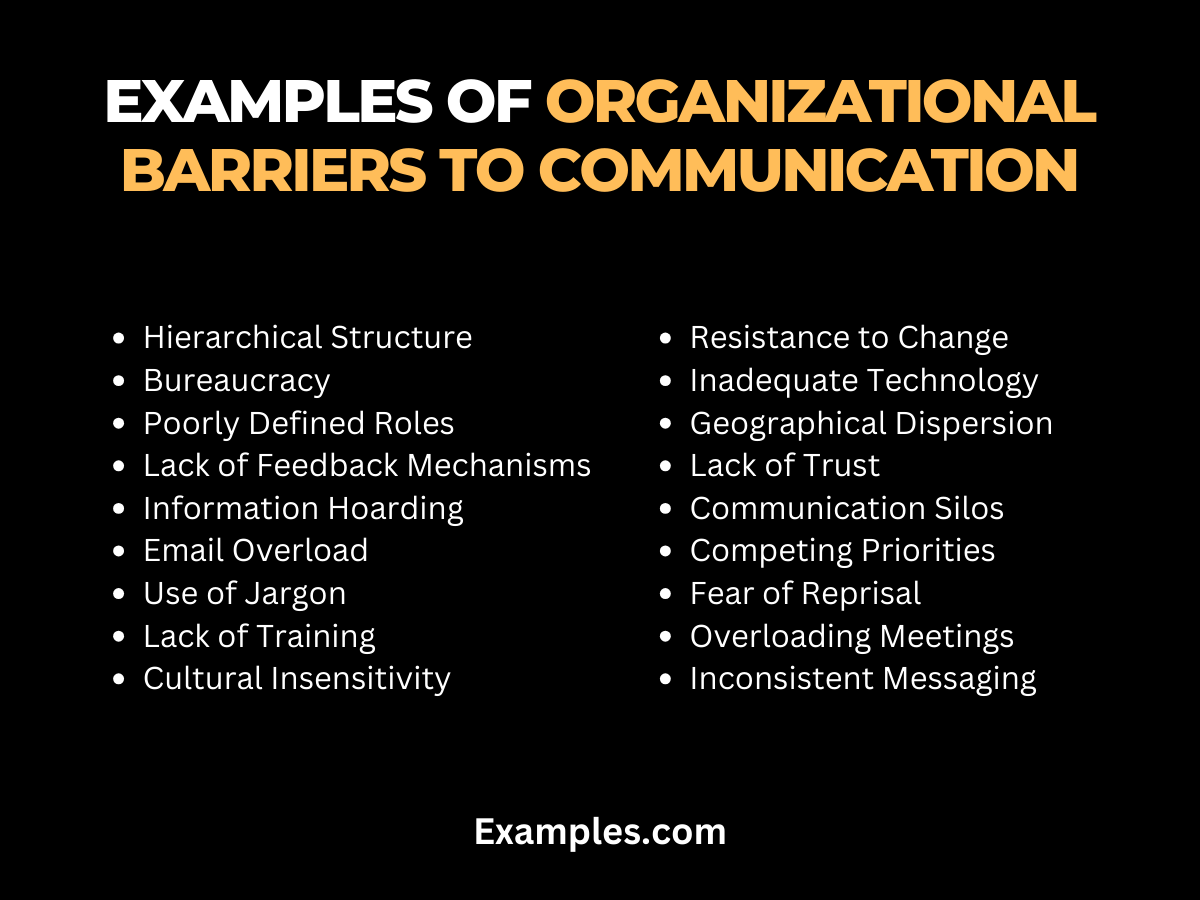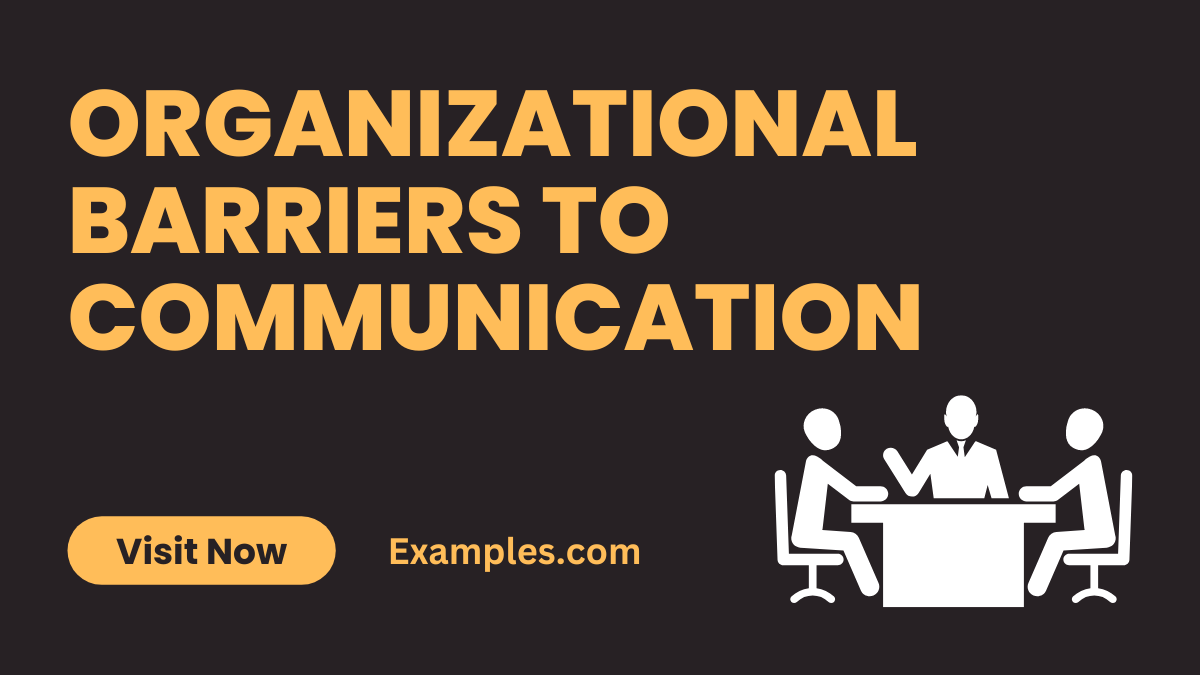19+ Organizational Barriers to Communication Examples
In today’s fast-paced world, effective communication is essential for any organization’s success. However, various organizational barriers can hinder this process. Understanding and addressing these barriers is crucial for achieving seamless communication within your workplace. In this comprehensive guide, we will explore the concept of “Organizational Barriers to Communication” and delve into practical solutions to ensure clear and efficient communication flows throughout your organization.
What are Organizational Barriers to Communication?

Organizational barriers refer to obstacles that impede the smooth exchange of information within a workplace. These barriers can stem from various sources, including structural, cultural, and interpersonal factors.
What is the Best Example of Organizational Barriers to Communication?

Imagine a large corporation with a rigid hierarchical structure where employees are discouraged from sharing feedback with their superiors. This creates a top-down communication barrier, hindering the free flow of ideas and valuable input from the workforce.
20 Examples of Organizational Barriers to Communication

These barriers encompass various aspects, from physical and language barriers to psychological and cultural hindrances. Each example includes a brief explanation of how these barriers can impact effective communication in an organizational context.
- Hierarchical Structure: In organizations with rigid hierarchies, employees may hesitate to communicate openly with higher-ups, hindering information flow.
- Bureaucracy: Excessive red tape and complex procedures can slow down communication processes.
- Poorly Defined Roles: When job roles and responsibilities are unclear, it can lead to misunderstandings and miscommunication.
- Lack of Feedback Mechanisms: Without proper feedback channels, employees may not receive timely input, affecting performance.
- Information Hoarding: Some individuals may withhold crucial information for personal gain, harming team collaboration.
- Email Overload: An overreliance on emails can result in information overload and missed messages.
- Use of Jargon: Excessive use of industry-specific jargon can confuse those not familiar with it.
- Lack of Training: Insufficient training on communication skills can hinder effective workplace interactions.
- Cultural Insensitivity: Failing to consider cultural differences can lead to misinterpretations and offense.
- Overemphasis on Written Communication: Relying solely on written communication may neglect the importance of face-to-face interactions.
- Resistance to Change: Employees resistant to organizational changes may not communicate openly about concerns.
- Inadequate Technology: Outdated or unreliable communication tools can disrupt efficient information sharing.
- Language Barriers within Teams: Multilingual teams may struggle with language-related misunderstandings.
- Geographical Dispersion: Remote teams may face difficulties in synchronous communication due to time zone differences.
- Lack of Trust: A lack of trust among team members can lead to guarded communication.
- Communication Silos: Departments or teams that don’t share information can hinder cross-functional collaboration.
- Competing Priorities: When employees are overwhelmed with tasks, they may not prioritize communication.
- Fear of Reprisal: Employees may hesitate to voice concerns if they fear negative consequences.
- Overloading Meetings: Excessive meetings can lead to burnout and unproductive communication.
- Inconsistent Messaging: When leaders convey mixed messages, it can confuse employees and create uncertainty.
How to Overcome Organizational Barriers to Communication
- Implement Clear Communication Policies: Establish clear, concise communication guidelines that address the flow of information within the organization. This includes setting expectations for response times and preferred communication channels.
- Enhance Transparency and Openness: Foster an environment where employees feel comfortable sharing their thoughts and feedback. Regular town hall meetings and open forums can promote this culture.
- Invest in Training: Provide training sessions focused on effective communication skills, conflict resolution, and cultural competence to enhance mutual understanding among diverse teams.
- Leverage Technology: Utilize modern communication tools and platforms that facilitate smoother information exchange, especially in geographically dispersed teams.
- Regular Feedback and Review: Conduct regular assessments of communication processes and implement changes based on feedback from employees at all levels.
What are the Effects of Organizational Barriers to Communication
- Reduced Productivity: Ineffective communication can lead to misunderstandings, causing delays and errors in project completion.
- Employee Disengagement: Poor communication often results in lower employee morale and engagement, impacting overall workplace atmosphere.
- Innovation Stagnation: A lack of open communication can stifle creativity and innovation, as employees may feel hesitant to share new ideas.
- Interdepartmental Conflicts: Miscommunications can lead to conflicts between departments or teams, hampering collaboration.
- Customer Dissatisfaction: External communication barriers can affect client relations, leading to dissatisfaction and potential loss of business.
Types of Organizational Barriers to Communication
- Hierarchical Barriers: Rigid hierarchical structures can hinder the free flow of information across different levels of the organization.
- Cultural and Language Differences: Diversity in language and culture can result in misunderstandings or misinterpretations.
- Technological Limitations: Inadequate or outdated technology can impede effective communication.
- Physical Barriers: This includes large office spaces or remote working arrangements that can limit face-to-face interactions.
- Psychological Barriers: Personal biases, attitudes, and emotions of employees can obstruct open communication.
Organizational Barriers to Communication in the Workplace
- Information Overload: Excessive information can overwhelm employees, making it difficult to process and respond effectively.
- Filtering Information: Distortion or withholding of information as it moves up or down the hierarchy can lead to misinformed decisions.
- Lack of Trust: A lack of trust among employees can lead to withholding of information and reluctance to communicate openly.
- Inadequate Listening: Poor listening skills can result in missing out on crucial information and cues during communication.
- Resistance to Change: Employees’ resistance to new policies or technologies can hinder the adoption of more effective communication methods.
Causes of Organizational Barriers to Communication
- Organizational Structure: Complex or unclear organizational structures can create confusion and obstruct the flow of information.
- Poor Leadership: Ineffective leadership can fail to motivate employees to communicate effectively and openly.
- Limited Feedback Channels: Lack of proper channels for feedback can restrict employees’ ability to express concerns and suggestions.
- Social Factors: Interpersonal relationships and dynamics in the workplace can influence the effectiveness of communication.
- Ambiguity in Roles and Responsibilities: Unclear roles can lead to confusion and ineffective communication among team members.
Organizational barriers to communication is essential for effective functioning. This article has provided valuable insights and practical tips for overcoming these hurdles. By promoting transparent communication channels, fostering a culture of openness, and utilizing appropriate tools, organizations can break down these barriers and enhance their overall communication effectiveness, leading to improved productivity and success.



